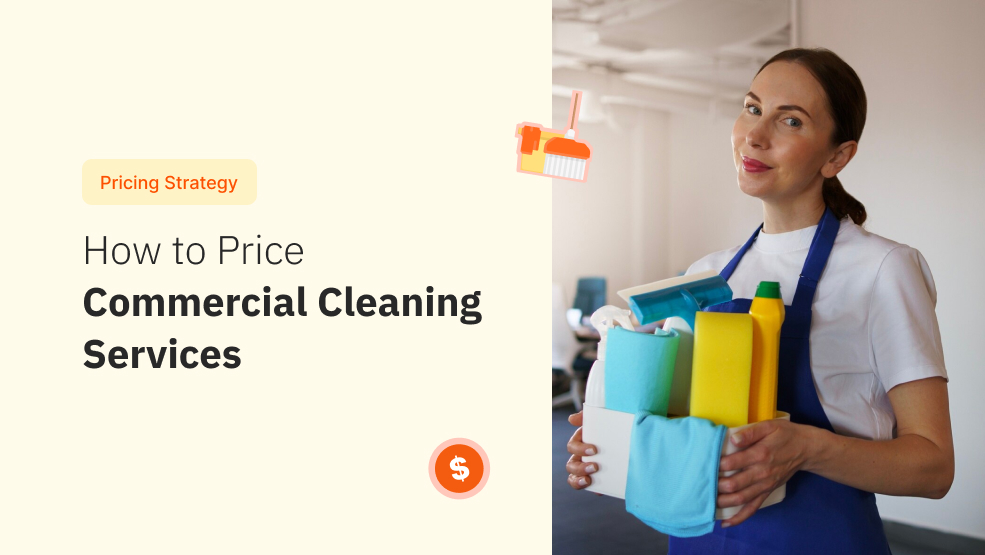To ensure profitability in commercial cleaning services, it’s crucial to determine accurate pricing. Material, labor, and overhead expenses all factor into establishing your break-even point. However, merely breaking even isn’t enough—you want to make a profit. The next critical question is, how much can you afford to charge for commercial cleaning services? This ultimately depends on how much your customers are willing to pay. In this blog, we explore these considerations in detail to help you set profitable rates.
1. Based on the on/off-peak hours
When calculating cleaning costs for your commercial cleaning business, consider using time-based pricing to incentivize clients to schedule cleanings during non-peak hours. This strategy can lower your labor costs and boost efficiency, making your services more attractive and cost-effective for both you and your clients.
2. Labor costs
A practical approach for determining labor rates is to multiply your direct labor costs—such as wages and payroll taxes—by 2.5 to 3 times. This multiplier covers your overhead and ensures a profit margin, providing a sustainable financial foundation for your business.
3. Equipment and supplies
Include the costs of supplies and equipment needed for each job. For example, expenses for vacuums, mops, dusters, and cleaning chemicals should be passed on to the client at cost or with a small markup. Accurately accounting for these expenses ensures you don’t undercharge for your services, maintaining profitability.
4. Value of your work
Don’t undervalue your work. Cleaners in high-end states with higher living costs will naturally charge more, despite other factors being constant. Recognizing the value of your services based on your location and market conditions helps you set appropriate rates that reflect the quality and expertise you offer.
5. Size and type of space
The size and type of space play a significant role in pricing. Larger spaces and those requiring specialized cleaning will demand higher costs due to increased time and supply needs. Industry average rates range between $0.07 and $0.15 per square foot, with hourly rates from $50 to $100 depending on the type of cleaning service. Various cost factors to consider include the frequency of service, location, services offered, and the number of cleaners required. Larger spaces or those needing high-detail cleaning may require more staff, thus increasing costs.
When considering other factors, think about the cost of specific cleaning products or tools, special requests like power washing, the time of day for cleaning, security requirements, whether you provide janitorial supplies, contract length, and customer turnover. Choosing the right pricing model—hourly rates, flat fees, square footage rates, or average room rates—can help you set fair and competitive prices while achieving your business objectives and delivering outstanding value to your clients.
Competitor pricing for commercial cleaning
Adjusting prices according to competitors is a common strategy in many industries. However, it doesn’t work well for commercial cleaning. The cost of cleaning services depends on various factors, such as building size, complexity, and the specific services required. When you constantly change prices based on competitors, it might not reflect the true cost of each job. This can lead to underpricing or overpricing of your services. So, a competitor pricing strategy won’t work for commercial cleaning services.
For instance, if a competitor offers a lower price, you might be tempted to match or beat that price to attract clients. However, this could mean you are not covering your actual costs, which include cleaning supplies, equipment, labor, and insurance. On the other hand, if you set your prices too high compared to competitors, you might lose potential clients who are price-sensitive. Therefore, relying solely on competitor pricing is not a sustainable strategy.
Instead, focus on understanding your costs and the value you provide to your clients. Set your prices based on these factors rather than constantly adjusting them based on what your competitors are doing. This will help you maintain profitability and provide consistent quality services to your clients.
Dynamic pricing for commercial cleaning
Dynamic pricing uses real-time data to adjust prices based on demand and other factors. This strategy is effective in industries where demand fluctuates throughout the day, such as ride-sharing or hotel bookings. However, cleaning contracts are typically pre-determined and don’t have the same level of real-time demand variation. So, a dynamic pricing strategy will not work for commercial cleaning.
For example, a ride-sharing service might increase prices during peak hours when demand is high and lower them during off-peak hours. In contrast, cleaning services are often scheduled in advance, with fixed prices agreed upon before the service is rendered. This makes it difficult to implement dynamic pricing effectively.
That being said, you can still use elements of dynamic pricing to your advantage. For example, you can offer discounts for clients who schedule cleaning services during less busy times, such as weekends or evenings. This helps you optimize your schedule and ensures that your cleaning staff is utilized efficiently. While dynamic pricing may not be fully applicable, finding ways to incorporate its principles can benefit your business.
Cost-plus pricing for commercial cleaning
Cost-plus pricing is a straightforward method for easily calculating the minimum price to cover costs and ensure profitability. To use this method, calculate all your business costs, including cleaning supplies, equipment, labor, insurance, and other expenses. Then, divide the total cost by the number of cleaning jobs you want to complete per week or month to get an average cost per job. Finally, add a desired profit margin percentage to the average cost to get your base price.
For example, if your total monthly costs are $10,000 and you aim to complete 100 jobs per month, your average cost per job is $100. If you want a 20% profit margin, you would add $20 to each job, resulting in a base price of $120 per job.
While cost-plus pricing ensures that you cover your costs and make a profit, it has its drawbacks. This method may lead to underpricing valuable services or losing customers to cheaper competitors. For instance, if you offer specialized cleaning services that require more effort and expertise, cost-plus pricing might not fully reflect the value of these services. Additionally, clients may compare your prices with those of competitors who use different pricing strategies, making it harder to compete. Again, pricing your service based on this is not highly recommended.
Price skimming for commercial cleaning
Price skimming involves setting a high initial price and gradually lowering it over time. This strategy is often used for new products or services that have a unique selling proposition. However, it isn’t practical for cleaning services because there is no “new product.” Clients expect fair pricing based on the service provided from the start.
For example, in the technology industry, a company might launch a new smartphone at a high price to attract early adopters and then gradually reduce the price to attract more price-sensitive customers. In contrast, cleaning services do not have the same product lifecycle. Clients typically look for consistent, fair pricing rather than high initial prices.
Therefore, price skimming is not a suitable strategy for commercial cleaning businesses. Instead, focus on providing excellent service at a fair and competitive price from the beginning. This will help you build trust and long-term relationships with both new and existing clients.
Introductory pricing for commercial services
Introductory pricing is a good way to attract new clients and gain market share. By offering a temporary discount, such as a reduced rate for the first month or a free additional service, you can entice potential clients to try your services. This strategy can be effective in gaining initial traction and building a client base.
For example, you might offer a 20% discount on the first month of cleaning services or include a free carpet cleaning with the initial contract. This can help you stand out from competitors and encourage clients to choose your services.
However, be cautious with introductory pricing. If not strategically planned, it can lead to the devaluation of your service in the long run. Clients might come to expect ongoing discounts and may not be willing to pay full price once the introductory period ends. To avoid this, clearly communicate the terms of the introductory offer and the value of your services at regular prices. Ensure that the quality of your service justifies the price once the introductory period is over.
Value-based pricing for commercial cleaning
Value-based pricing focuses on the value your services provide to clients. This strategy considers the benefits of your services, such as improved hygiene, productivity, and maintenance. By basing your prices on these benefits, you can attract clients who appreciate and are willing to pay for the value you offer.
For instance, emphasize how your cleaning services contribute to a healthier work environment, which can reduce employee sick days and increase productivity. Highlight the long-term benefits of regular maintenance, such as prolonging the lifespan of office equipment and fixtures. By showcasing the value of your services, you can justify higher prices and build strong relationships with clients who recognize this value.
Value-based pricing requires a deep understanding of your clients’ needs and the specific benefits your services provide. Conduct surveys, gather feedback, and continually improve your services to ensure that you are delivering value. This approach helps you differentiate yourself from competitors and fosters client loyalty.
Price bundling
Price bundling involves creating attractive packages for specific cleaning needs. This strategy works well for cleaning services, as clients often have varied requirements. By bundling services together, such as seasonal deep cleaning and carpet cleaning, you can offer a comprehensive solution at a competitive price.
For example, you can create different cleaning bundles, such as a basic cleaning package, a deep cleaning package, or an eco-friendly package. Each of these bundles can include a set of services that complement each other, providing true value to the client. Bundling services can also encourage clients to purchase more comprehensive packages, increasing your overall revenue.
When implementing price bundling, ensure that the bundled services complement each other and meet the client’s needs. Clearly communicate the benefits of each package and how it addresses specific cleaning requirements. This will help clients see the value in choosing a bundled package over individual services.
Psychological pricing
Psychological pricing subtly influences customer perception of your services. This strategy involves using pricing tactics that make prices appear more attractive. For example, use price points ending in $0.95 or $0.99 instead of rounded numbers. A service priced at $99.95 may seem more appealing than one priced at $100, even though the difference is minimal.
Another psychological pricing tactic is to emphasize value by framing your pricing in a certain way. For example, highlight the savings clients will get by choosing your services or compare your prices to competitors to show the better deal.
However, psychological pricing has become so common that clients may not find it as attractive or discounted anymore. It has become an obvious marketing initiative, and clients might see through it. Therefore, use psychological pricing sparingly and in combination with other pricing strategies to avoid appearing manipulative.
Time-based pricing
Time-based pricing incentivizes clients to schedule cleanings during off-peak hours or weekdays. This strategy can work well for cleaning services, as it helps optimize your schedule and ensure that your cleaning staff is utilized efficiently.
For example, offer discounts for clients who book cleaning services during evenings or weekends when demand is typically lower. This encourages clients to choose times that are more convenient for their business, helping them balance their workload and avoid scheduling conflicts.
To implement time-based pricing effectively, clearly communicate the benefits to clients. Explain how they can save money by choosing off-peak times and ensure that the quality of service remains consistent regardless of the time. This approach can help you attract more clients and make better use of your resources.
Find what works for your business
In conclusion, selecting the right pricing strategy for your commercial cleaning business depends on understanding your costs, the value you provide, and your clients’ needs. Pricing models we discussed have their advantages and drawbacks By carefully considering these strategies and tailoring them to your business, you can set fair and competitive prices that attract clients and ensure profitability.
Step up and be a force for good. For every T-shirt you wear, over 700 gallons of water is consumed. You hold the power to reclaim gallons of water with every garment you wear. Choose minimalism; Save water. Mindful closet for a sustainable future!




